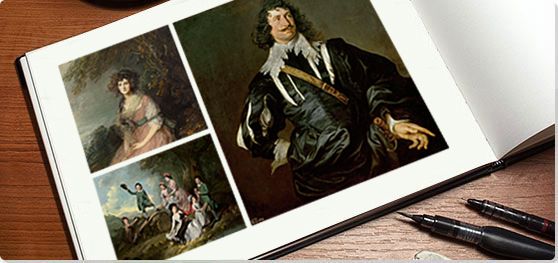Summary of Grand Manner
The term Grand Manner has come to refer to a style of portraiture that emerged in Britain during the eighteenth century. It is attributed to the founder of the Royal Academy of Arts, Sir Joshua Reynolds, who alluded to a "grand style" in his Discourses on Art lecture series delivered to Academy students between 1769 and 1790. In his fourth lecture (Fourth Discourse) he argued that this approach "gives what is called the grand style to invention, to composition, to expression, and even to colouring and drapery". Artists were thus encouraged to draw on the lessons of the past by closely observing the styles of classical Greek and Roman art and masters from the Italian Renaissance (especially Raphael, Michelangelo, and Carracci). Reynolds's intervention came when he suggested that if the same standards of excellence were applied to portraiture then it could compete on an even critical footing with history painting. Reynolds had effectively initiated a new stylistic approach that would be claimed subsequently as the "Golden Age of British portraiture". Through the influence of painters such as Gilbert Stuart, John Trumbull and John Singer Sargent, moreover, the Grand Manner style would travel across the Atlantic, where it would make a significant contribution towards America's artistic and political "coming of age".
Key Ideas & Accomplishments
- The "Grand Manner" grew out of Reynolds's conviction that "common" portraiture might attain the prestige reserved hitherto only for history painting. He predicted, correctly as it transpired, that a British school of art would attain international influence by elevating portraiture, which it did by establishing explicit links to the art of antiquity, to the status of fine art.
- As the president of the Royal Academy, Reynolds wanted painters to be afforded the same status enjoyed by poets, dramatists, and philosophers and argued that to achieve this then the artist should strive to produce faultless forms rather than slavishly detailing nature or every-day life. The art historian Cecil Gould observed that in Reynolds's vision "Landscape backgrounds or ornamental detail must be reduced to a minimum and individual peculiarities of human physiognomy absolutely eliminated [while] Draperies should be simple, but ample and noble, and fashionable contemporary costume absolutely shunned".
- The Grand Manner was adopted by elite artistic institutions (namely European royal academies) who positioned themselves as both art education centers and the latest tastemakers. The new social symbolism associated with classically posed, life-sized portraits, set against idealized landscapes and interiors, put in place a new hierarchy that effectively demoted "less important" genre paintings such as still lifes and scenes of everyday life.
- The Grand Manner was adopted by a new generation of American artists, including Gilbert Stuart, Thomas Scully, and John Trumbull, who effectively formed the county's first art dynasty. Stuart, arguably America's foremost portraitist, brought a subtle dimension of realism to the Grand Manner style and in so doing helped form the historical vision of heroes of the American Revolution and the pioneers of the new republic.
Overview of Grand Manner
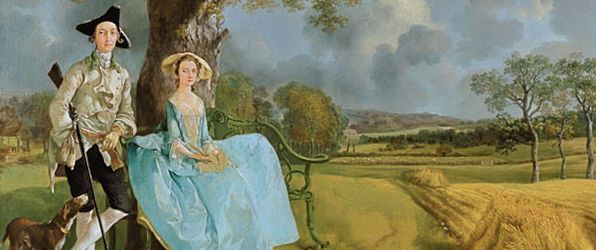
Gainsborough painted, in the words of art historian John Rothenstein, "wonderful" and "lovingly observed" figures placed in pastoral settings "so touching in [their] beauty" they have "never ceased to haunt the English imagination".
The Important Artists and Works of Grand Manner
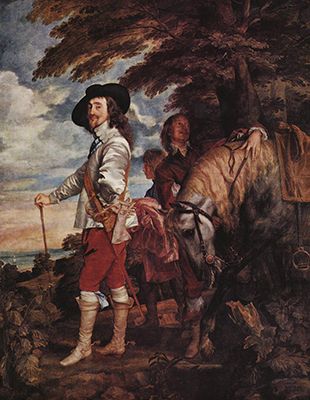
Le Roi á la Chasse (Charles I at the Hunt)
This portrait depicts Charles I as he turns toward the viewer in a relaxed but regal stance. Behind him two male attendants stand beside his horse: one tending to the welfare of the animal; the other looking attentively into the distant sky. Rather than a formal portrait, the King is portrayed at ease in van Dyck's leisurely and informal treatment. As art critic Richard Dorment noted, "when you see his vividly naturalistic portraits next to the stiff and hieratic work of his English predecessors, it is Van Dyck's theatricality that is so striking". The gloves he holds in his left hand, his walking stick evoking a scepter, and a Latin phrase, reading "Charles I, King of Great Britain" inscribed on a rock in the right foreground, emphasize his status as sovereign. Here Charles plays the part of the ideal courtier, the "perfect gentleman" as he was described in Baldassare Castiglione's The Book of the Courtier (1528), a treatise that influenced court life throughout Europe for almost two centuries.
The King's clothing - specifically his wide-brimmed hat and silvery doublet shimmering with light - is luxurious, while the outdoor setting conveys the sense of oneness with nature. Van Dyck's portraits were seen as precursors for the Grand Manner style, and his advocacy for outdoor settings allowed for intimate portraits that conveyed the innate virtues of the sitter. As art critic Keith Thomas, noted "nearly all the great 18th-century portraitists, from Pompeo Batoni and Allan Ramsay to Thomas Gainsborough and Joshua Reynolds, copied Van Dyck's costumes, poses and compositions".
Oil on canvas - Musée du Louvre, Paris
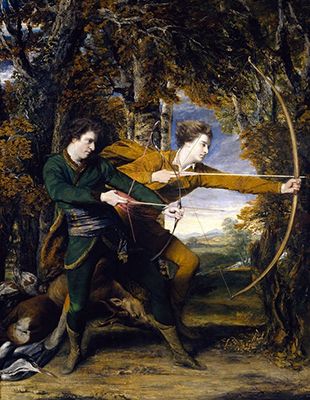
Colonel Acland and Lord Sydney: The Archers
This life-size double portrait depicts Lord Sydney in dark green, and, behind him, Colonel John Acland who steps forward with his bow fully drawn. Framed by forest foliage that opens out onto a meadow, and with the spoils of their hunt laying on the forest floor behind them, the two men are presented to the viewer as heroic aristocratic medieval hunters.
Though at the time shotguns were generally used for hunting, archery had become fashionable amongst the aristocracy and the figure of the young and virile archer had become a fashionable motif in art. As art historian Ruth Kenny observed, "The painting celebrates the men's friendship by linking it to an imaginary chivalric past, when young lords pursued 'manly' activities together against a backdrop of ancient forest. The two subjects run and take aim in perfect rhythmic harmony; at one with each other and joint masters over nature". Yet Reynolds invented these aristocratic costumes to evoke the chivalric past, as the art critic Richard Dorment noted, "His compulsion always to move in new directions is linked to his conviction that portraiture could attain the prestige associated with history painting only through the exercise of the painter's imagination [...] At the root of all this lay his lifelong ambition to establish a school of British painting of international importance".
In 1768 Reynolds became the first president of the newly formed Royal Academy of Arts and the following year was knighted by King George III. Painted in the same year that he began presenting his Discourses on Art to the Academy, and this painting was intended to make a personal statement whereby, as Ruth Kenny noted, Reynolds "demonstrated his desire to elevate portraiture to the level of high art, alongside the genre of history painting". He exhibited this painting in the Royal Academy's 1770 exhibition where it met with great acclaim.
Oil paint on canvas - Collection of the Tate, United Kingdom
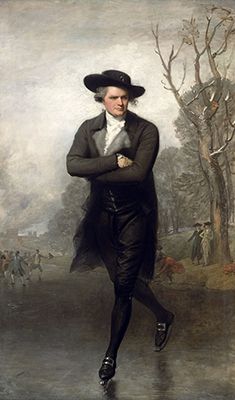
The Skater (Portrait of William Grant)
This life-size work depicts William Grant, arms folded, his head slightly turned and lowered beneath a broad brimmed hat, as he skates gracefully in the general direction of the viewer. His clothing, dark but illuminated by the highlights of the white cravat, the gray lapel and silver buckles on his shoes, confirm Grant's stylish elegance. His full-skirted coat, meanwhile, flares out slightly giving a palpable sense of movement as he glides across the picture frame from right to left. The portrait, with the majesty of nature captured in the receding trees and low horizon, epitomizes the Grand Manner style and demonstrates its influence upon the first generation of American artists.
In 1775, and following the example of other American artists such as John Singleton Copley, Stuart travelled to England where he studied with Benjamin West for six years (even exhibiting a portrait of his mentor at the Royal Academy in 1781). The Skater was Stuart's first full-scale portrait. An aristocratic Scotsman, and excellent ice skater, Grant commissioned the artist, but, on the day he was due to sit for his portrait, Stuart recalled how Grant had said "on account of the excessive coldness of the weather [...] the day was better suited for skating than sitting for one's portrait". Accordingly, the two men went skating in London's Hyde Park, and Stuart painted the portrait quickly, and from memory. Exhibited at the 1782 Royal Academy exhibition, the work was met with such acclaim that Stuart said he had been "suddenly lifted into fame by a single picture". Patrons flocked to him for portraits, and his reputation began to rival that of both Gainsborough and West.
After eighteen years in Britain and Ireland, Stuart, by now in debt and hounded by creditors, returned to the United States where he established a studio in Philadelphia. He became reborn as a leading portrait artist, known particularly for his many portraits of George Washington, the first president of the United States. His work influenced other American artists, including Thomas Sully, John Vanderlyn, Washington Allston, and, the "painter of the Revolution", John Trumbull.
Oil on canvas - The National Gallery of Art, Washington DC
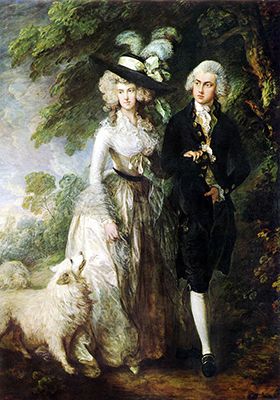
Mr and Mrs William Hallett ("The Morning Walk")
This double portrait portrays William Hallett and Elizabeth Stephen, arm in arm and accompanied by a white Pomeranian, on a morning walk through the countryside, just prior to their marriage. Revealing van Dyck's influence, Gainsborough used light and fluid brushstrokes to capture the early light shimmering in the couples' resplendent finery; the soft edges of Elizabeth's dress, its lace sleeves and bodice echoed in the soft rolling foliage. Viewers of the era took the work as a visual metaphor of marital happiness, though, implicitly, the painting also conveys the confident virtue of the British character, the world as its garden. Additionally, the dog functions as a symbol of fidelity, and also incorporates a uniquely British association. Queen Charlotte had first brought a pair of Pomeranians (then larger than the modern breed) to England in 1767 and the Pomeranian became firmly associated with the royal family. As art critic Holland Cotter noted, Gainsborough's Grand Manner portraits, "helped invent the image in art of the new social and intellectual English elite".
Gainsborough was one of the founding members of the Royal Academy and, as a portraitist, his arch rival was Joshua Reynolds. In the 1770s he began to promote landscape settings in many of his portraits, bringing a more informal and poetic approach (as seen here) to the more formal style of marriage portraiture. Van Dyck also influenced Gainsborough's use of landscape settings, for which he would develop a marked preference: "I am sick of portraits and wish very much to take my viol-da-gam [stringed instrument] and walk off to some sweet village, where I can paint landskips (sic) and enjoy the fag end of life in quietness & ease". Yet, many of his idealized "Arcadia" landscapes were painted from imagination, as he arranged stones and pieces of plants, even sometimes vegetables, on a table in his studio to use in modeling. As art historian Michael Rosenthal wrote, he was "one of the most technically proficient and, at the same time, most experimental artists of his time". Though a highly accomplished portraitist, Gainsborough is credited as the founder of the British landscape school and his works influenced John Constable, who once said "On looking at [Gainsborough's landscapes] we find tears in our eyes and know not what brings them".
Oil on canvas - The National Gallery, London
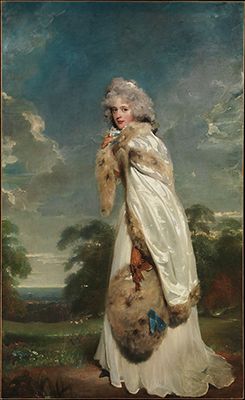
Portrait of Elizabeth Farren
This portrait depicts Elizabeth Farren, an Irish actress who had become famous after her 1777 debut in Oliver Goldsmith's play She Stoops to Conquer (1773). Acting primarily in comedies of manners, she performed at the celebrated Theatre Royal in London, and Lawrence's portrait captures her at the height of her fame. Dressed in shimmering white satin, adorned with a fur collar and border, and carrying a fur stole, she turns to face the viewer as if caught by surprise on a walk through the countryside. As art critic Richard Holmes described it, "Her seductive figure is offset by a provocative display of textures: muslin, fur, satin and silk, and above all perhaps her limp, leather chamois gloves. Each is rendered with sharp, voluptuous appreciation". The open vista behind her, with its dark blue and gathering skies, enhances what Holmes calls the work's "sense of Romantic style and flamboyance".
Exhibited in 1790 at the Royal Academy, the portrait established Lawrence's role as successor to Joshua Reynolds, though the exhibition was not without a little controversy; Farren having been offended by the title Portrait of an Actress rather than Portrait of a Lady, and also the sense that Lawrence had over-stressed her slenderness. Nevertheless, the Regency era was known for its flamboyance and theatricality and the Grand Manner portrait could play a role in enhancing one's status. Indeed, in 1797 Farren married the earl of Derby and retired from the theatre, and some attributed the notable match to Lawrence's seductive and compelling portrait.
Coming of age in the Romantic era, Lawrence was a child prodigy, and his father, a tavern-keeper, encouraged his art, taking him to London where he launched his career when he was just 17. His work immediately won the support of Reynolds and the patronage of the Duchess of Devonshire. At the age of 25, he was elected to the Royal Academy. As Holmes wrote, "Lawrence was painting his own generation, and effectively bringing it on to the stage of history", with an approach that was "deliberately theatrical, dressy and provocative". His reputation declined in the Victorian era, as the novelist Thackeray in Vanity Fair (1847) described his portraits as "tawdry". Holmes notes that in the modern era, "It became a witticism to say his only successor was the fashion photographer Cecil Beaton". Yet, while Victorian England turned away from his portraits, the French, acknowledging his influence, awarding him the Légion d'honneur in the 1820s. The French novelist Stendhal even declared that "Mr. Lawrence's name is immortal". The artist's work has received renewed contemporary interest with the 2011 National Portrait Gallery's exhibition Thomas Lawrence: Regency Power and Brilliance.
Oil paint on canvas - The Metropolitan Museum of Art, New York, New York
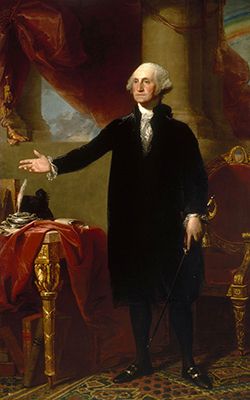
George Washington
This portrait shows George Washington, commander of the American Revolutionary Army and the first president of the United States, as he stands, wearing a black velvet suit. His left hand holds a sword, and his right hand extends in an oratory gesture that evokes classical depictions of the Roman emperors. His resolute, somewhat tight-jawed, expression conveys a sense of somber gravitas. Behind him two Doric columns, partially wrapped in red drapes, evoke a classical architectural setting, opening on one side to an open and cloudy sky and on the far right to a rainbow, symbolizing the revolution followed by peace. A chair on the right is topped with a medallion colored like the American flag, while on the table to the left are several books, including the Federalist and Journal of Congress, evoking the Constitutional Convention and the founding of the new country. Every detail is symbolic, as the table's leg resembles both the mace used in the House of Representatives and a fasces, a Roman symbol of power, while two reclining silver dogs on the silver quill holder's base represent loyalty.
Born in America, Stuart moved to London in 1775 and eventually studied with Benjamin West and achieved great success as a portraitist. He returned to the United States in 1793 where he hoped to paint Washington and other notables in the Grand Manner style. The former British Prime Minister William Petty, the Marquis of Lansdowne, who had overseen the peace agreement that ended the war, commissioned the portrait, and Stuart was able to obtain a single sitting with the president. The portrait is thought to depict a moment following Washington's 1795 address to Congress where he called for unity following the fierce debate over the Jay Treaty, meant to resolve remaining issues between Great Britain and the United States following the war.
Stuart's portrayals of Washington, widely reproduced, have become an integral part of American history, though artistic appreciation of his work has lagged in the modern era. As historian James Thomas Flexner noted, "Stuart sought a public image - what the individual showed to the world [...] yet if we study a picture carefully, we discover that Stuart's revelation of character is profound. Stuart told a pupil that he preferred Vandyke [sic] to Reynolds because Vandyke was true to nature. 'If a sitter had false eyes, they were put down as false. Reynolds would not. He delighted too much in imaginary beauty'".
Oil on canvas - National Portrait Gallery, Smithsonian Institute, Washington DC
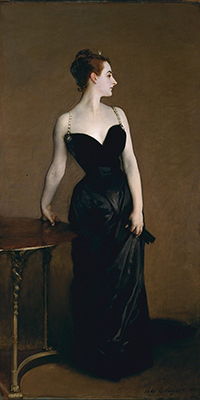
Madame X (Madame Pierre Gautreau)
This full-scale portrait depicts Virginie Amélie Avegno Gautreau, an American socialite who was married to the Parisian banker Pierre Gautreau. Dressed in black satin décolleté, she creates a striking and sensual pose, as the dark warm brown background emphasizes her skin's alabaster tone, enhanced by the application of lavender powder. Her face turns to her left, while her body faces the viewer, her right hand grips the edge of a small table, while her left hand holds a closed black fan. The pose emphasizes her neckline and shoulders - what Sargent called her "élancée figure" - while also alluding to Francesco Salviati's classical Roman fresco cycle, Bathsheba goes to David (1552).
Other subtly-deployed classical allusions include the sirens of Greek myth carved into the table's legs and Gautreau's crescent tiara accessory which symbolized Diana, the Greek goddess of the hunt. These motifs evoke the past but also allude the subject's character since Gautreau was both celebrated for her beauty and rumored to have had a number of love affairs. A number of artists in Paris sought to paint Gautreau's portrait, though she had refused all requests before Sargent. He envisioned exhibiting the work in the Paris Salon and thought it would attract commissions from new patrons while Gautreau hoped that a Grand Manner portrait, and one painted by a leading master, would enhance her social standing.
Originally, the jeweled strap of her dress had partially fallen down her right shoulder, and, when the work was exhibited as Portrait de Madame XXX at the 1884 Salon, a scandal ensued, causing Gautreau humiliation. The effect on Sargent, meanwhile, was described by art critic Jonathan Jones who wrote, "Displayed in the huge jury-selected exhibition [...] it horrified Parisians so much that the ignominy drove Sargent across the Channel to take refuge in Britain. Of course, it was the making of him. He always kept Madame X in his studio. Its whiff of naughtiness generated demand for his portraits with a fashionable British and American public".
Echoing the Grand Manner, but bringing it into the modern era with its Impressionistic touch and its sharp portrayal of the subject, the work was called "a monument to American art" by the art critic Jonathan Jones. Though Sargent did not exhibit it again for another twenty years, he came to regard it as his best work. The work's implicit modernism also seemed to encompass an awareness of the new social age. As art historian Stephanie L. Herdrich wrote, "Perhaps what astounded viewers the most was that the ambitious, young Sargent had boldly portrayed a new brazen 'type' in Parisian society: the so-called professional beauty, a woman who audaciously used her appearance to gain celebrity and advance her social standing".
Oil on canvas - The Metropolitan Museum of Art, New York, New York
Beginnings
The Renaissance
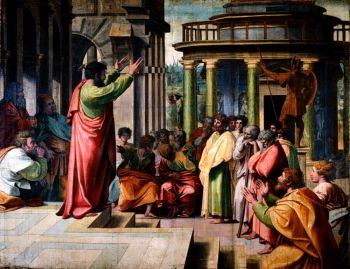
In his treatise on the theory of painting, De Pictura (1436), the Italian humanist architect and writer, Leon Battista Alberti, advocated the use of classical principles and an idealized treatment of subjects in painting. He argued that history painting was the highest ranked artform on the grounds that it required technical mastery, a solid education in the classics, and must serve a moral purpose. The resultant works would produce an edifying effect on the viewer, affording them qualities of virtue and nobility of character. In the era that followed, Raphael's frescos, which employed Biblical and classical narratives involving notable figures to convey the theme of spiritual and worldly wisdom, were presented as exemplars of early Grand Manner painting. But it was Raphael's Cartoons (1515-16) - seven large designs, depicting the lives of St. Paul and St. Peter, painted for Pope Leo X as Sistine Chapel tapestries - that had the most direct impact on the development of the Grand Manner. The eminent Swiss art historian Heinrich Wölfflin described the cartoons as "the Parthenon sculptures of modern art" and they had a profound influence on artists like Carracci and the French émigré Nicolas Poussin. In 1623 King Charles I of England purchased the Cartoons and, once housed in England, they duly imparted their influence on British artists.
Giovanni Pietro Bellori
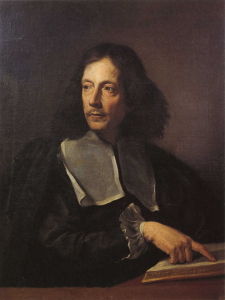
Giovanni Pietro Bellori prefigured the concept of the Grand Manner in his Vite de' Pittori, Scultori et Architetti Moderni (Lives of the Artists) (1672) where he advocated an idealized and classical approach to painting, as exemplified in the works of Renaissance artists Raphael, Michelangelo and Alberti. Modelling his biography on Giorgio Vasari's seminal Lives of the Artists (1550), Bellori argued that artists should "form in their minds [...] an example of superior beauty and, reflecting on it, improve upon nature until it is without fault". Such works, he argued, would be understood by "higher spirits" though not by commoners who were inclined to "praise things painted naturalistically".
Bellori's Lives of the Artists promoted the likes of Caravaggio, Peter Paul Rubens, Anthony van Dyck, Lanfranco, Domenichino, Barocci, Poussin, the Carracci brothers, the sculptors Alessandro Algardi and François Duquesnoy, and the architect Domenico Fontana. Emerging from this most illustrious company of artists, Bellori offered Annibale Carracci's work as the very epitome of the Renaissance revival. The art historian Julius von Schlosser observed that Bellori's biography was so influential he became "the most important historiographer of art not only of Rome, but all Italy, even of Europe, in the seventeenth century". Indeed, his ideas became so widely influential they were adopted by Charles Le Brun, director of the French Académie Royale de Peinture et de Sculpture, and by several influential British aristocrats and patrons.
Annibale Carracci
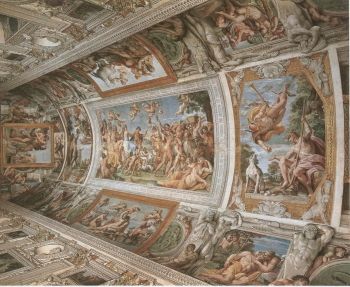
The art historian Keith Christiansen noted that, with brother Agostino and cousin Ludovico, Annibale Carracci, "set out to transform Italian painting [by rejecting] the artificiality of Mannerist painting [and] championing a return to nature". In 1595 Annibale travelled to Rome to work for the Farnese family, where, influenced by the work of the Renaissance masters, he painted his fresco cycle The Loves of the Gods (1597-1601) in the Farnese Palazzo. The monumental work depicted narratives of the Greek gods, painted as classically inspired figures within an illusionistic architectural setting. Bellori viewed the work as representing a timeless ideal - "Human Love Governed by Celestial Love" - and resisted the aesthetic temptations of the artificial and over-elaborate style that characterized the dominant Mannerist style. Carracci promoted rather a return to the subtle naturalism as explored previously by Titian, Tintoretto, Veronese, and Correggio. Carracci's classical and idealizing approach directly influenced the likes of Rubens and Poussin and by the 1630s the first manifestation of the Grand Manner style had been adopted as the benchmark for Academic art.
Anthony van Dyck
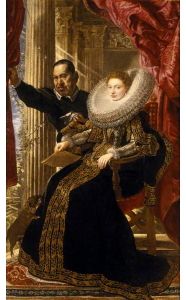
Anthony van Dyck had studied with the Flemish artist Hendrick van Bale from the age of ten, and established his own studio when he was still in his teens. However, he gave up his studio to work with Peter Paul Rubens in 1617. The Baroque master was a leading artist of the day, his work combining a dramatic exuberance with a deep knowledge of classical sculpture and Renaissance painting. Rubens's portraiture was noted for its lively informality and classical elements, as seen for instance in his Marchesa Maria Grimaldi and her Dwarf (c.1607) which Van Dyke referenced in his painting A Genoese Noblewoman and Her Son (c. 1626). Rubens would become a key influence on van Dyck but it is thought that he would have been conversant with the techniques of the two other key figures working within the contemporary Flemish Baroque style: Frans Hals and Judith Leyster.
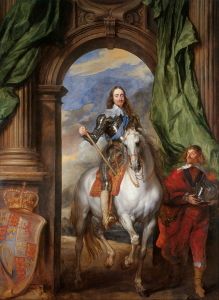
In 1621 van Dyke moved to Italy (via a short stay in England) where he met Bellori who commented that "his behaviour was that of a nobleman rather than an ordinary person, and he shone in rich garments". Van Dyke spent six years in Italy, associating with artists in Bellori's circle, before returning to Flanders. Meanwhile, the British King Charles I, an avid collector and patron of the arts, had recruited noted artists (including Rubens for a period of nine months in 1630). With the support of his aristocratic connections, van Dyck moved to London and became part of Charles's royal court in 1632. He was to reside in England for the rest of his life (notwithstanding brief trips overseas) as he became celebrated (and knighted) for his many depictions of the King, his family and members of his royal court. The portraits, conveying the grandeur of his subjects with a lively sense of movement, color and stylish elegance, became known as the "cavalier" style, and offered a template for the development of the Grand Manner, and what would become known as the "swagger portrait".
Joshua Reynolds
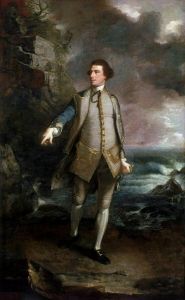
Joshua Reynolds developed the style of portraiture following his return in 1752 from an extended trip to Italy where he studied classical ruins and Renaissance masterpieces. His Captain the Honourable Augustus Keppel (1752-73) was a full-length portrait of the maritime officer who was also a longtime friend and patron. The portrayal revealed the influence of classical art and history painting in the way it showed Keppel, in a pose echoing that of the Apollo Belvedere (120-140 CE), striding onto a rocky shore after his 50-strong gun boat had been wrecked off the Normandy coast in 1747. Reynolds's creation of an "action scene", with the heroic figure shown in dynamic movement, was highly innovative and much acclaimed. The portrait established his reputation and allowed him to establish a studio in London. The leading portraitist of the day (not to mention a "man of letters") he became co-founder and first president of the Royal Academy of Art in 1768.
Between 1769 and 1790 Reynolds delivered fifteen influential lectures at the Royal Academy (later published as Discourses on Art). His Third and Fourth Discourses (1770 and 1771) promoted what he called "the grand style". Reynolds singled out Raphael's Cartoons (1515-16) for especial praise, stating: "How much the great style exacts from its professors to conceive and represent their subjects in a poetical manner, not confined to mere matter of fact, may be seen in the cartoons of Raffaelle (sic). In all the pictures in which the painter has represented the apostles, he has drawn them with great nobleness; he has given them as much dignity as the human figure is capable of receiving". The Grand Manner would demand that detail and background elements should be minimal and selective and function only as a kind of visual metaphor that informed on the nobility of the character. His term "grand style" or "great style" subsequently became known as the Grand Manner. Viewing the Grand Manner as central to a distinctive British art, he also viewed it as the culmination of the classical tradition, as he wrote, "the gusto grande of the Italians, the beau idéal of the French, and the great style, genius, and taste among the English, are but different appellations of the same thing".
The American Grand Manner
According to the art historian E. H. Gobrich, by "the eighteenth century, English institutions and English taste became the admired models for all people in Europe who longed for the rule of reason" (Academies in other words). But in Europe, unlike America, the Grand Manner style was having to compete with the "more delicate and intimate effects" of artists such as Jean-Baptiste Simeon Chardin whose "quiet glimpses of ordinary life" recalled Vermeer "in the way they "preserve[d] the poetry of a domestic scene".
While America's supreme colonial-era portraitist John Singleton Copley headed in the opposite direction (his precise portraits had garnered the approval of Reynolds and Benjamin West who persuaded him to refine his innate talents in England where, like his compatriot West, he added history painting to his already impressive portraits repertoire). Reynolds saw his influence extend across the Atlantic to a number of first generation American artists; names such as Gilbert Stuart, Ralph Earl, Charles Wilson Peale, John Trumbull, Thomas Sully, Samuel F.B. Morse, Charles Wilson Peale and his son Rembrandt Peale. The Peales, located in Philadelphia, became well known for their Grand Manner portraits, while Trumbull, working as both an architect and a painter, created the National Academy of Design in New York which he hoped would rival the excellence of the Royal Academy in London. Some American artists had established studios in London and, on their return to the United States, introduced the Grand Manner style to an audience eager for high quality portraiture. These artists promoted an American art that would rival and surpass the European tradition and portray the leaders of the American Revolution and the newly formed republic in a heroic light.
Concepts and Styles
The Swagger Portrait
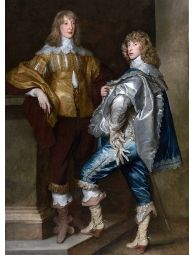
Though portraiture had a long history of aristocratic and wealthy subjects desirous of visual confirmation of their elevated station in life, Anthony van Dyck is generally credited as the pioneer of the "swagger portrait", that being a form of portraiture that made a public statement; or a "conversation piece". Sitters adopted a cavalier pose that expressed an attitude of insouciance - or "swagger" - that gave the subgenre its name. This style was exemplified in a number of van Dyck's portraits showing aristocrats resplendent in their finery and exaggerating, or "cutting", a pose. As art critic Richard Dorment noted, "With his sumptuous swagger-portraits of the court of King Charles I, Van Dyck transformed the history of painting" in Britain.
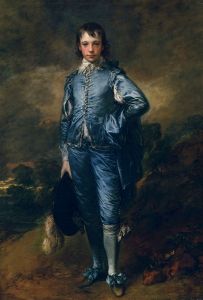
Thomas Gainsborough's The Blue Boy (c. 1770) paid homage to van Dyck's The Children of King Charles I of England (1637) (a portrayal of Charles II as a boy, dressed in red silk). By the late 1700s even middle class sitters commissioned swagger portraits, with Joseph Wright of Derby, for instance, employing backgrounds with rich draperies or classical columns to portray the cotton manufacturer Samuel Oldknow (1790-92). Swagger portraits, painted by John Hoppner and Thomas Lawrence, continued to be popular through the 19th century, and John Singer Sargent's elegant and stylish portraits were particularly celebrated examples, as seen, for example, in his Portrait of Lady Agnew of Lochnaw (1892). Psychologically revealing, such works eschewed the Grand Manner's classical allusions to noble virtue in favor of a more modern approach that showed off the personality of the sitter. Moving into the twentieth century, Augustus John, Britain's leading portraitist, expanded the range of the swagger portrait beyond aristocrats to include well-known writers such as the playwright George Bernard Shaw, and movie stars like Tallulah Bankhead.
History Painting and Contemporary Events
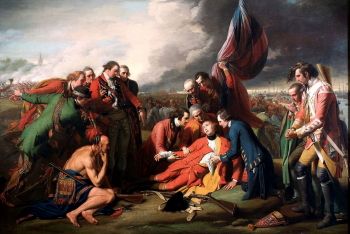
Just as the Grand Manner showed contemporary figures as idealized representations of virtue and nobility, so history painting began to import contemporary figures into heroic narratives. Despite its name (history painting), the genre had typically portrayed multi-figured mythical narratives taken from the Bible, Greek mythology and Roman history rather than contemporary historic events. The move towards contemporary events was fuelled by the emergence of modern states and a rising sense of nationalism, and in 1760 the Society of Artists of Great Britain established two annual prizes for paintings depicting British history. Benjamin West, an American painter came to Britain to study with Joshua Reynolds. As the King's official history painter, and second president of the Royal Academy, he took up lifelong residence in London, becoming a leading proponent of this style following the exhibition of his celebrated and controversial The Death of General Wolfe (1770). Portraying the general's heroic death on the battlefield as his army achieved victory at the 1759 Battle of Quebec, West innovatively painted the figures in contemporary dress, rather than classical costume. Archbishop Drummond, who was West's long-time patron, and Joshua Reynolds urged the artist to paint the figures in Roman togas, but Wolfe protested, "the same truth that guides the pen of the historian should govern the pencil of the artist".
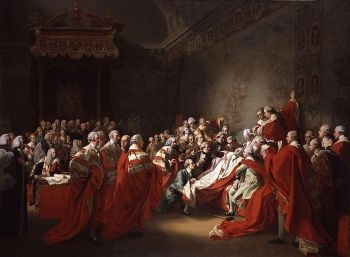
As public exhibitions grew in number and frequency, paintings that depicted national history were often the most popular with audiences, especially those by two American ex-patriots, West and Copley. As the art historian Stephen Mark Caffey noted, "To follow the trajectory of history painting's rise, relevance and obsolescence is to track Britons' negotiation of their global status as a 'free though conquering people'". In Caffey's view "Imperial anxiety afforded history painting its short-lived relevance among English-speaking audiences during the second half of the eighteenth and first quarter of the nineteenth centuries, and imperial self-acceptance rendered that most highly-esteemed of artistic genres obsolete".
Empire and Revolution
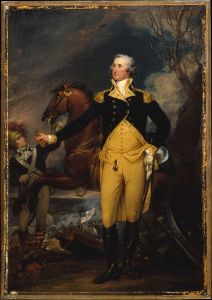
In 1769, the year in which King George III established The Royal Academy of Art, Britain was an emerging global empire. The art critic Jonathan Jones noted that "Reynolds placed art at the centre of national political and public life [arguing] that beauty was as important as money and guns in Britain's imperial destiny". In his first lecture as newly appointed president of the Royal Academy, Reynolds argued that what was needed for the emerging empire was "elegance and refinement", an ideal art that would portray the moral virtue of British character and one worthy of governing the globe. Indeed, Reynolds's artistic allusions connected notable contemporaries to the glory and grandeur of the Roman Empire. In America, Gilbert Stuart, Charles Willson Peale, and John Trumbull (among others) used the Grand Manner to depict the founding fathers as idealized figures of a new republic, one equivalent, perhaps, to that of a new Roman republic.
Later Developments
Grand Manner portraiture began to decline at the fin de siècle as the style was seen as "last century" and pretentious. In 1907 Sargent closed his studio (though he continued to paint landscapes) while Augustus John took the mantle of Britain's leading portraitist through the 1920s (though several critics noted his artistic decline following World War I). The artists of the Grand Manner had, nevertheless, left their mark on subsequent generations with Joshua Reynolds and Thomas Gainsborough leaving their indelible imprint of British and international art history. Their influence extending to the works by John Singleton Copley, James Northcote, Hugh Barron, Gilbert Stuart, J.M.W. Turner, John Constable and James Abbott McNeill Whistler. Indeed, Reynolds's lectures, his role in founding the Royal Academy and his life-long presidency, helped shape the very development of art education.
There has been a renewed interest in Sargent's work after 1950s. His portraits influenced the look of Andy Warhol's early work; Warhol remarking that Sargent "made everybody looks glamorous. Taller. Thinner". Sargent also influenced contemporary British portraitist Isabelle Watling and contemporary American artists Kehinde Wiley and Jordan Casteel. A New York gallery held a 2014 exhibition - Sargent's Daughters - which included the works by forty women artists "exploring the legacy of John Singer Sargent". The art critic Jonathan Jones noted that "Sargent's fascination with the dress and style of the best people created some of the most haunting portraits of the modern world" and that the style and dress of his (in)famous Madame X portrait continues to influence fashion, fashion photography, and modern celebrity culture. In a 2008 article that featured thirteen leading actresses wearing Madame X-inspired black dresses, fashion critic Lauren Hubbard called Sargent's society portrait, "The painting that launched a thousand fashion designs".
The Grand Manner has had the greatest impact on national historical and cultural consciousness, defining for many what it meant to be British or American. It also greatly influenced 20th century fashion photography, as seen in the photographs of Cecil Beaton, Richard Avedon, Irving Penn, and Annie Leibovitz. For her part, Cindy Sherman, in her "society portraits" (2008) revisits Grand Manner portraiture with a strong sense of irony. As art historian Paul Moorhouse wrote, "Pictured against backdrops that strain to convey an effect of history and substance [Sherman's] women pose for the camera in attitudes that strike a note of imperious, self-conscious importance. However, the ambiance they have fabricated and inhabit is, like the backdrops Sherman employs, strangely empty [...] Ornate, intricate and patterned their elegance is, nevertheless, ersatz".
 Ask The Art Story AI
Ask The Art Story AI